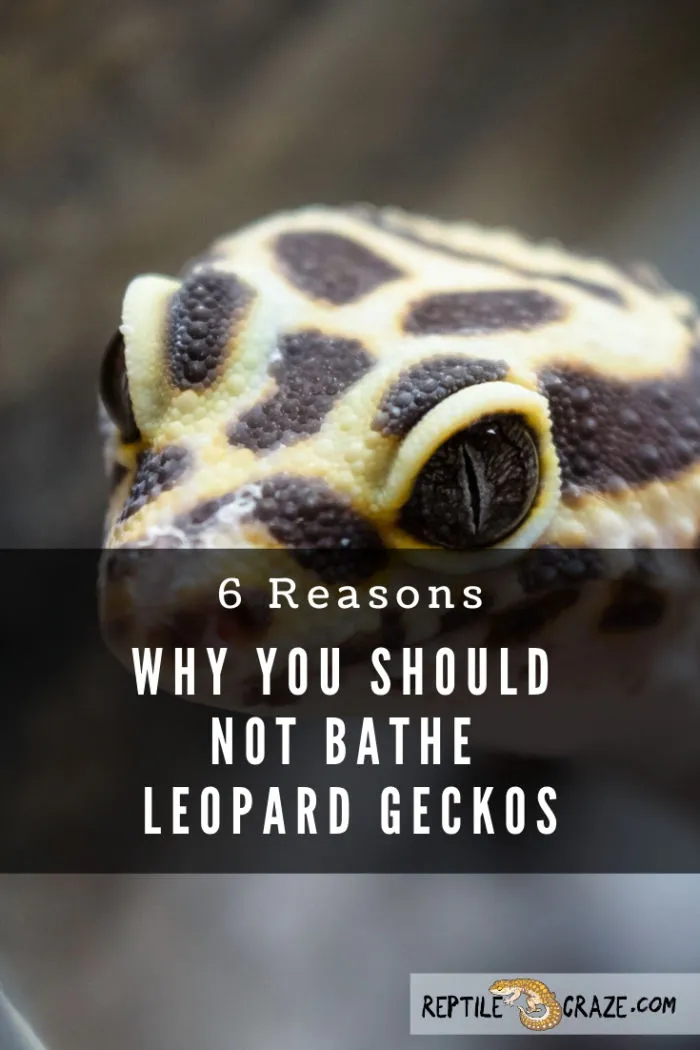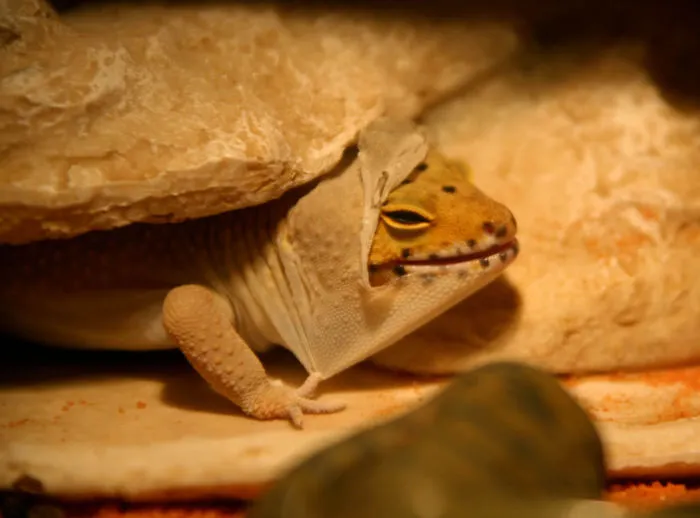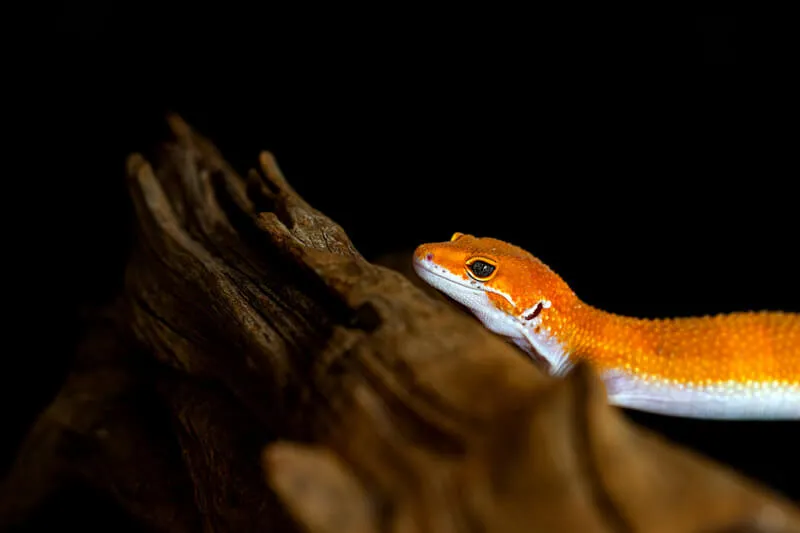 Did your leopard gecko get a little dirty somehow? Naturally, your first thought would be to give the reptile a bath so they can feel clean and safe, plus avoid getting sick as a result of being unsanitary. However, it is not advised that you do this.
Did your leopard gecko get a little dirty somehow? Naturally, your first thought would be to give the reptile a bath so they can feel clean and safe, plus avoid getting sick as a result of being unsanitary. However, it is not advised that you do this.
Why you should not bathe your Leopard Gecko? They don’t like water and they don’t really need a bathe. Bathing can stress your Leo. But If your little buddy is impacted or constipated, you can give him a bath (with caution) to help with this.
Keep reading to discover a few reasons why bathing a leopard gecko is not a good idea, and the few occasions it should be done.
Table of Contents
When Is It OK to Give My Leo a Bath?
It is important to understand that leopard geckos come from a climate that is dry and, as a result, do not need a bath often.
In the event that the gecko is having some issues shedding, you can absolutely provide a bath for your gecko.
You would use a q-tip, tweezers, or fingers to help gently remove any skin. It is important to remove any shed skin as it can cut off the circulation of the blood, which can lead to loss of toes.
Another time that your gecko may need a bath is when they are impacted, or in other words, constipated.
Lastly, the only other occasion on which you should bathe your leopard gecko is when they are covered in their own fecal matter.
Sometimes these reptiles run through their own feces, and this creates the need to take a bath. (To prevent this, you should be cleaning the habitat every day of fecal matter).
Aside from this, baths aren’t necessary.
Now, let’s explore some reasons as to why bathing isn’t a necessary practice.
Reason 1: They Don’t Really Need Them
If you have to bathe your gecko, it should be only because there is a need to do so. Some examples include shedding, impaction, or when they are dirty.
If you are lucky, this will take place just once or twice per month. Aside from this, you can help your gecko stay healthy in other ways. For example, make sure heat is adequate inside the habitat to ensure proper digestion.
Also, make sure moist hides are adequate for shedding. You can also spray your leopard gecko while he is shedding in order to help him get that old skin off.
Reason 2: They Don’t Like Water
Leopard geckos do not like water, despite the fact that they need a humid and moist place to hide and thrive.
These creatures are unique in that having water in their atmosphere is critical to their well-being – as is the act of drinking water in adequate amounts- but ironically, they don’t care to be in it.
They can become stressed out quickly if you place them in a tub of deep water, plus this increases their chances of drowning.
If you must bathe your leo, it is critical that you don’t fill their bathtub with too much water. It is important to understand that leopard geckos cannot swim and do not care to be in the water.
Reason 3: It’s Uncomfortable for Them
Imagine yourself as a leopard gecko. You cannot get your old skin off. You cannot go to the bathroom because you ate something you shouldn’t have or because it is far too cold for your liking in your home. Or, you have your own fecal matter stuck to your feet.
Any of these situations are enough to make a person feel unclean and uncomfortable, much less a leopard gecko.
Now imagine that you have to be placed into a situation where you have no way of defending yourself. Pretend you have no ability to swim, and you are being placed into a deep pool that could be far too cold for your liking anyway.
Now on top of your discomfort, your safety is being threatened.
It doesn’t sound like a great way to spend a day. Your leopard gecko doesn’t deserve to be stressed out more than they already are. The bottom line? Make sure your gecko truly needs a bath, and when it is administered, it is done right.
Reason 4: They Could Drown
Leopard geckos cannot swim. You may have seen some YouTube videos or photos of geckos appearing to walk on water, but that by no means geckos enjoy swimming or staying cool in the water like some animals do.
Leopard geckos also cannot stay in that “walking on water” state for a long period of time. They can and will tire themselves out and slip under the surface of the water.
Sadly, some owners have told stories of the times they walked in only to find their gecko stuck in the water dish, helplessly trying to get out of the uncomfortable situation. (Side note- this is the main reason water dishes should be shallow).
If the leopard gecko faces in the wrong direction, or panics, they could slip underwater and drown as the end result. The video below clearly shows how stressed leopard geckos are when they have to swim while getting a bath.
Reason 5: They Could Drop Their Tails
If you have a leopard gecko, you know that you should NEVER handle the reptile by their tail. This puts them at extreme risk for dropping their tail, which is a defense mechanism.
Being exposed to water leaves the reptile open to being in extreme stress. These animals do not like water. As a result of being stressed out, the reptile could altogether refuse to come out for
Lack of eating
Reason 6: They Can’t Breathe Properly While Swimming
The body of a leopard gecko is not meant for contact with water. Swimming is a very body- intense process that requires extreme exertion of the lungs and muscles in the body.
The leopard gecko does not have this kind of strength. The temperatures associated with water are also causation for weakness in your leopard gecko.
Water takes heat away from the leopard gecko, leaving him exposed to a sudden temperature drop and opening him up to getting sick.
Impaction or Constipation
The other word for impaction is constipated. It is one of the few reasons a leo should be getting a bath. Human beings know what it is like to be constipated, and it is not enjoyable at all, and it is not enjoyable for leos, either.
You can prevent impaction in your leopard gecko’s
To start, using a loose substrate such as sand is not recommended. Bugs wider than the span between the eyes of the leopard gecko are also not recommended.
You should also make sure the
Heat under the belly is necessary for this process to take place. Your best bet is to install a good under
If your leo is impacted, you can give a bath to help with this. During the process of bathing, you will massage the gecko’s belly from the top to the vent. Avoid contact with the throat.
You will massage the belly for five minutes and then soak him for five more minutes. Repeat the process until the leopard gecko makes a fecal elimination.
However, this should not be the case provided you are monitoring your equipment and
I DO Have to Give My Leo a Bath. How Do I Do It?
If you have read through this list and still require a bath for your leopard gecko, we will now explore methods of bathing your gecko that will keep him as comfortable and happy as possible during an otherwise stressful scenario.
Is your leo really dirty? Make sure to check for a shed that hasn’t dropped off in a reasonable amount of time or dirt trapped on your leo’s feet or body.
Make sure your hands are clean. Use an organic, plant-based soap free of scents and perfumes. It will prevent any unpleasant smells from bothering your leo, and more importantly, will prevent you from transferring germs to your gecko.
Rinse your hands thoroughly. Hands must also be washed AFTER Handling your gecko.
Locate a small, shallow container and fill it with just a half-inch of warm water. Make sure this container is used for nothing but bathing your leo- do not use a container that has been used for any other purpose.
The water level should only touch the belly. The water should also be warm- 80 to 90 degrees F is appropriate. You will not need to use any soap; warm water is adequate for this particular task.
To aid in shedding, allow the leo to soak in the water for a few minutes. Pour the water on his back and allow the water to moisten the skin. Do not get water on or near the eyes of your leo.
To make the water a bit softer, you can add a small drop of mineral oil to the water. It can help with the act of shedding and help it fall off easier.
Washing the Gecko
Suppose you have to wash the gecko. You can do this by taking a q-tip and gently rubbing the skin to clean the dirt away from your gecko. It helps rid the gecko of dirt. Do not use the q tip or any other tool to pull away at shedding skin.
Drying the Gecko
Once you have gently removed the dirt from the skin of your leopard gecko, make sure to dry them off thoroughly using a paper towel or soft washcloth.
Now wrap the leo in the cloth, making sure their head is still open so they can see what’s going on. Gently dab the cloth or towel to help dry them off.
If you use paper towels, make sure they are discarded immediately.
If you use washcloths, disinfect them when finished.
Finishing Up
Make sure you place the leopard gecko back into his habitat immediately. Be sure to disinfect your washcloths if used. Make sure to thoroughly wash your hands after the leo is placed back into his
Conclusion
In closing, the act of bathing a leopard gecko should only be done under very specific circumstances.
These circumstances include impaction, fecal matter or dirt being stuck to the leopard gecko, or if the reptile is having difficulty shedding his skin.
Good leopard gecko care will help eliminate the need to bath your leo. Make sure the
The end result is a leopard gecko that is a lot happier and healthier!
- Eastern Rat Snake: Nature’s Pest Control and Fascinating Reptile - September 20, 2024
- Eastern Racer: The Fast and Agile Snake - September 19, 2024
- The Eastern Indigo Snake: The Majestic, Non-Venomous Hunter of the Southeast - September 18, 2024
